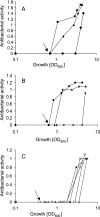The lantibiotic mersacidin is an autoinducing peptide
- PMID: 16980420
- PMCID: PMC1636175
- DOI: 10.1128/AEM.00723-06
The lantibiotic mersacidin is an autoinducing peptide
Abstract
The lantibiotic (lanthionine-containing antibiotic) mersacidin is an antimicrobial peptide consisting of 20 amino acids and is produced by Bacillus sp. strain HIL Y-85,54728. The structural gene (mrsA) and the genes for producer self-protection, modification enzymes, transport proteins, and regulator proteins are organized in a 12.3-kb biosynthetic gene cluster on the chromosome of the producer strain. Mersacidin is produced in stationary phase in a synthetic medium (K. Altena, A. Guder, C. Cramer, and G. Bierbaum, Appl. Environ. Microbiol. 66:2565-2571, 2000). To investigate the influence of the alternative sigma factor H on mersacidin biosynthesis, a SigH knockout was constructed. The knockout mutant was asporogenous, and a comparison to the wild-type strain indicated no significant differences concerning mersacidin production and immunity. Characterization of the mrsA promoter showed that the gene is transcribed by the housekeeping sigma factor A. The biosynthesis of some lantibiotic peptides like nisin or subtilin is regulated in a cell-density-dependent manner (M. Kleerebezem, Peptides 25:1405-1414, 2004). When mersacidin was added at a concentration of 2 mg/liter to an exponentially growing culture, an earlier production of antibacterial activity against Micrococcus luteus ATCC 4698 in comparison to that of the control culture was observed, suggesting that mersacidin itself functions as an autoinducer. In real-time PCR experiments, the expression of mrsA was remarkably increased in the induced culture compared to the control. In conclusion, mersacidin is yet another lantibiotic peptide whose biosynthesis can be regulated by an autoinducing mechanism.
Figures




Similar articles
-
Role of the single regulator MrsR1 and the two-component system MrsR2/K2 in the regulation of mersacidin production and immunity.Appl Environ Microbiol. 2002 Jan;68(1):106-13. doi: 10.1128/AEM.68.1.106-113.2002. Appl Environ Microbiol. 2002. PMID: 11772616 Free PMC article.
-
Biosynthesis of the lantibiotic mersacidin: organization of a type B lantibiotic gene cluster.Appl Environ Microbiol. 2000 Jun;66(6):2565-71. doi: 10.1128/AEM.66.6.2565-2571.2000. Appl Environ Microbiol. 2000. PMID: 10831439 Free PMC article.
-
Expression of the lantibiotic mersacidin in Bacillus amyloliquefaciens FZB42.PLoS One. 2011;6(7):e22389. doi: 10.1371/journal.pone.0022389. Epub 2011 Jul 21. PLoS One. 2011. PMID: 21811596 Free PMC article.
-
Quorum sensing control of lantibiotic production; nisin and subtilin autoregulate their own biosynthesis.Peptides. 2004 Sep;25(9):1405-14. doi: 10.1016/j.peptides.2003.10.021. Peptides. 2004. PMID: 15374644 Review.
-
Posttranslationally modified bacteriocins--the lantibiotics.Biopolymers. 2000;55(1):62-73. doi: 10.1002/1097-0282(2000)55:1<62::AID-BIP60>3.0.CO;2-Y. Biopolymers. 2000. PMID: 10931442 Review.
Cited by
-
Bacillus velezensis 83 a bacterial strain from mango phyllosphere, useful for biological control and plant growth promotion.AMB Express. 2020 Sep 7;10(1):163. doi: 10.1186/s13568-020-01101-8. AMB Express. 2020. PMID: 32894363 Free PMC article.
-
Modular Use of the Uniquely Small Ring A of Mersacidin Generates the Smallest Ribosomally Produced Lanthipeptide.ACS Synth Biol. 2022 Sep 16;11(9):3078-3087. doi: 10.1021/acssynbio.2c00343. Epub 2022 Sep 5. ACS Synth Biol. 2022. PMID: 36065523 Free PMC article.
-
Production of the novel two-peptide lantibiotic lichenicidin by Bacillus licheniformis DSM 13.PLoS One. 2009 Aug 26;4(8):e6788. doi: 10.1371/journal.pone.0006788. PLoS One. 2009. PMID: 19707558 Free PMC article.
-
Analysis of a bac operon-silenced strain suggests pleiotropic effects of bacilysin in Bacillus subtilis.J Microbiol. 2020 Apr;58(4):297-313. doi: 10.1007/s12275-020-9064-0. Epub 2020 Jan 28. J Microbiol. 2020. PMID: 31989543
-
Heterologous Expression of Mersacidin in Escherichia coli Elucidates the Mode of Leader Processing.ACS Synth Biol. 2021 Mar 19;10(3):600-608. doi: 10.1021/acssynbio.0c00601. Epub 2021 Mar 10. ACS Synth Biol. 2021. PMID: 33689311 Free PMC article.
References
-
- Augustin, J., R. Rosenstein, B. Wieland, U. Schneider, N. Schnell, G. Engelke, K.-D. Entian, and F. Götz. 1992. Genetic analysis of epidermin biosynthetic genes and epidermin-negative mutants of Staphylococcus epidermidis. Eur. J. Biochem. 204:1149-1154. - PubMed
-
- Bierbaum, G., H. Brötz, K. P. Koller, and H. G. Sahl. 1995. Cloning, sequencing and production of the lantibiotic mersacidin. FEMS Microbiol. Lett. 127:121-126. - PubMed
-
- Brötz, H., G. Bierbaum, P. E. Reynolds, and H. G. Sahl. 1997. The lantibiotic mersacidin inhibits peptidoglycan biosynthesis at the level of transglycosylation. Eur. J. Biochem. 246:193-199. - PubMed
-
- Chatterjee, S., S. Chatterjee, S. J. Lad, M. S. Phansalkar, R. H. Rupp, B. N. Ganguli, H. W. Fehlhaber, and H. Kogler. 1992. Mersacidin, a new antibiotic from Bacillus: fermentation, isolation, purification and chemical characterization. J. Antibiot. 45:832-838. - PubMed
Publication types
MeSH terms
Substances
Associated data
- Actions
LinkOut - more resources
Full Text Sources
Other Literature Sources
Medical
Molecular Biology Databases

